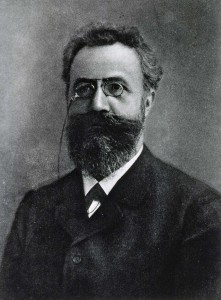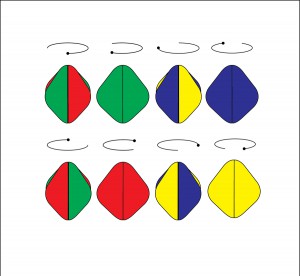Hermann Ebbinghaus (1850-1909) was a German psychologist who pioneered the experimental psychology of memory. He is mostly known for his discovery of the forgetting curve (describes how the ability of the brain to retain information decreases in time), the learning curve (graphical representation of the rate at which you make progress learning new information) and the spacing effect (phenomenon whereby information is learned and retained more easily and effectively when its studying is spread out over time).
However, Hermann Ebbinghaus has also been known thanks to its colour system. Indeed, the concept of the double pyramid gained in popularity thanks to the latter.
In 1902, he proposed a new version of Hofler’s double pyramid. Ebbinghaus constructed a colour system rest on this system of double pyramid but made few modifications: he put rounded corners and an inclined central plane.
He rounds off the corners of the solid as he considered the transition between colours as fluid and not sharply defined. The Hering-type fundamental opponent colours are located at the six corners (black, green, red, blue, yellow, white).
The resulting chromatic body, from the four primary colours, links Leonardo da Vinci’s idea that colours vary in brightness and can thus be differentiated. The idea was to separate and so distinguish those four colours due to the variation of brightness.
The base-square of the double solid is tilted in such a way that the best yellow hues, which are relatively bright, are nearer to white, and the best blue tones, which are relatively dark, are nearer to black. His system does not predict the mixtures of colours and the complementary pairs are not arranged opposite one another.


In 1893, Ebbinghaus published a «Theory of Colour Vision» in the Zeitschrift für Psychology (Journal of Psychology), in which he mentioned that humans perceive colours through higher mental processes. As a psychologist, he knew about the perception of the four elementary colour (yellow, red, green, blue) and thanks to physiologists knew there were only three photo-sensitive substances in the eye’s retina (rods, cones, photosensitive retinal ganglion cells) thanks to which the phenomenon of coloured vision and its anomalies could be explained.
In addition, Ebbinghaus has discovered that two white hues produced by spinning either red and green or blue and yellow, appeared to be the same at certain levels of brightness, but appeared different when the illumination was reduced or the speed was reduced.




